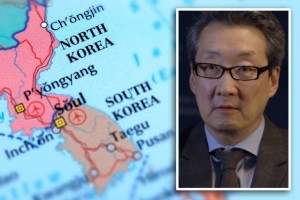Special to WorldTribune.com
A North Korean invasion of the South would ultimately fall to the superior military technology of the U.S. and South Korea, but “not without four to six months of high-intensity combat and many dead,” a former White House adviser said.
In his new book “The Impossible State”, Victor Cha describes how a North Korean invasion would play out, a war that would cost the West “$100 billion to fight and cause $1 trillion worth of damage.”

Cha, who worked under President George W. Bush, said in an interview with The Daily Star that the invasion would begin with North Korean special forces launching a series of predawn airdrops and shore landings, sabotaging power stations, communication networks and bridges in order to “paralyze the population.”
The North’s artillery – “the largest artillery force in the world” – would pound the South Korean capital Seoul with shells at a rate of 500,000 per hour — leaving its people only 45 seconds to take cover.
An arsenal of 600 chemically-armed missiles would cripple airports, making escape impossible, while 100 more trained on Japan would slow the arrival of U.S. reinforcements.
Any opposing forces attempting to cross the Tsushima Strait into the South would face waters infested with Kim Jong-Un’s submarines, “all of them told to torpedo American supply ships.”
As all that unfolds, some 700,000 North Korean troops and 2,000 tanks “would pour across the border, with invasion tunnels discovered as deep as 475ft down — some capable of shifting 30,000 fighters an hour.”
Road networks would be impassable as millions of civilians flee, leaving defensive forces helpless, Cha wrote.
The battlefield would be polluted with up to 5,000 metric tons of chemical agents, including nerve gas, mustard gas, choking and vomiting agents, and perhaps even weaponized diseases.
“As wars go,” writes Cha, “this would be the most unforgiving battle conditions that could be imagined.”
Before South Korea and its American allies could neutralize the North’s invasion, hundreds of thousands would be left dead.
“Short of dropping tactical nuclear weapons on the battlefield it would be impossible to neutralize all of this without the North first inflicting major damage on Seoul,” Cha wrote.
“The obsolescence of DPRK equipment and training does not mean they are rendered harmless. No matter how old the gun or artillery system is, it can still fire on Seoul and do damage — [but] it does mean they will ultimately be defeated by U.S.-ROK combined forces.”
Cha writes: “After the experience of American bombing and napalm during the Korean War, the North sought refuge by burrowing deeper underground than anyone else in the world, making the country like a block of Swiss cheese, with caverns and tunnels everywhere.”
Beneath Kim Il-Sung Square in the heart of Pyongyang, a bunker command post with fresh water, ventilation and a secret escape tunnel is believed to have room for 100,000 men.
Kim Jong-Il “kept 1,000 of the very best as his personal guard, no two of them related, in order to ensure their first loyalty was to the leader,” Cha wrote. “Command centers, factories and food and fuel depots with six months of supplies are also buried beyond the reach of American bombers.”
So far the sheer cost to both sides has kept the peace, Cha said, “but with the regime becoming increasingly unpredictable, it’s unclear how long the balance will last.”
